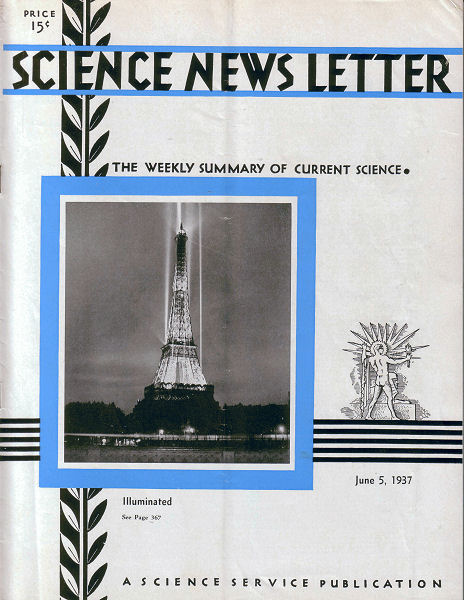From the June 5, 1937, issue

EIFFEL TOWER IS LIGHTED TO HONOR PARIS EXPOSITION
As in Chicago during the Century of Progress Exposition, modern illuminating art is playing its part in Paris, adding to the city’s customary gayety in honor of the occasion of the Exposition Internationale. The festive illumination of the Eiffel Tower is shown on the front cover.
At the Paris exposition, which will be held from now until November, prominence will be given to art industries. The first group of exhibits contains an initial section on scientific discoveries.
TRANSMUTATION OF ELEMENTS CHANGES CHLORINE INTO ARGON
A new transmutation of the elements in which the chlorine atoms in common table salt are changed first into potassium and then into the inert gas argon is reported by Princeton University scientists. The transmutation is one of the first achieved with the new cyclotron apparatus now in operation after a year’s construction period. Ionized helium atoms are the bombarding source of energy, which brings about the elemental change.
Prof. Henry D. Smyth, chairman of the physics department at Princeton, made announcement of the work by the four-man research team of Dr. Milton G. White, Drs. Malcolm C. and William J. Henderson and Dr. Louis N. Ridenour.
The form of potassium created, indicated Prof. Smyth, lacks one neutron and exists for a brief interval. Its average life is 10.8 minutes.
ACCURATE, CHEAP LENSES MADE FROM TRANSPARENT PLASTIC
Spectacle lenses produced at a rate of 1,500 an hour instead of being ground slowly and laboriously by hand, are only one possibility of the new transparent resin molded lenses now being exhibited in America by two British inventors. Eyeglasses for all who need them at a cost measurable in cents instead of tens or twenties of dollars may some day be the result of thus achieving a long-held dream of molding optical lenses instead of fashioning them tediously by hand.
Good-quality lenses on low-price cameras and binoculars are another possibility already realized on a small scale. The entire important movement of copying the world’s scientific and historic literature on microfilm and making it cheaply available to anyone anywhere, is also closely bound up with securing an inexpensive optical viewing device which one could carry in the pocket or keep in a desk drawer.







